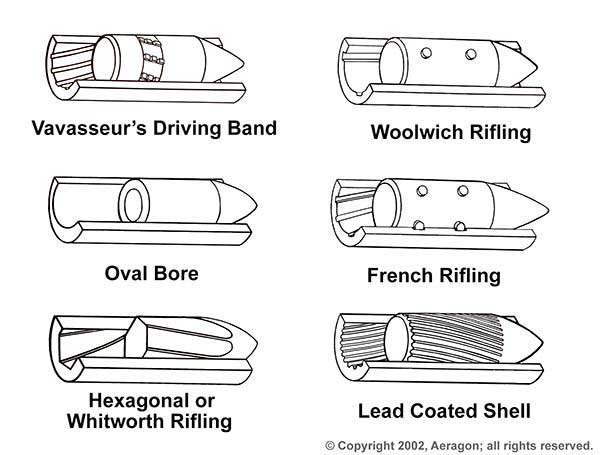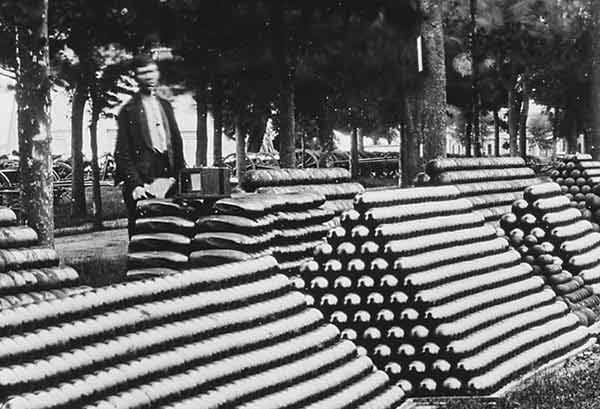Elongated Shells
Although the inefficiencies of spherical ammunition had been appreciated by artillerymen for a considerable time, it was not until the mid-nineteenth century that serious development of elongated projectiles was undertaken.

Elongated Shells.
Image: © 2002 Aeragon; all rights reserved.
- Vavasseur’s Driving Band was developed to preserve the rifling in cannon, as an improvement over lead-coated shells and to reduce windage around the shell. The band consisted of a copper ring that had copper-wire studs that rode in the rifling grooves of the gun, thereby imparting spin to the projectile. Only one wire rode in any particular rifling groove - a position attained upon firing. Josiah Vavasseur and T. A. Blakely, R. A. co-invented and patented the device on 11 January 1866. Her Majesty’s Government extended the patent in 1879. Vavasseur partnered in the ordnance business with T.A. Blakely, R. A. and Sir William George Armstrong at different times. (Most of this information is from, The Engineer, 1866 & 1879).
- Oval Bore – was a design for rifling where the bore of the gun was an oval that was rotated in helix fashion down the tube of the gun.
- Hexagonal or Whitworth rifling was where the shell and bore were hexagonal and section profile rotated in a helix down the bore of the gun. Where the Whitworth name is used, it refers to Sir Joseph Whitworth, founder of the Whitworth Ordnance Company. In addition to this innovation in ordnance, Whitworth developed many advancements in tool and die making and industrial standards.
- Woolwich Rifling was a design used by the Royal Gun Factory at Woolwich. The design used studs fitted into the shell that rode in the rifling grooves in the bore of the gun. Sometimes, the studs were called shunts. This design had certain problems in that it wore down the rifling grooves very rapidly although the studs were made of soft metal. Because of the small contact area between the studs and the rifling grooves, windage once again became a big problem.
- French Rifling was a design very similar to Woolwich rifling with the position of the studs and grooves being the main difference. It suffered from the same problems as the Woolwich design.
- Lead Coated Shells were sometimes used to avoid some of the problems with windage and wear to the bore. Lead coated shells had some advantages; in that, the muzzle bore of the gun could be made slightly larger than the bore at the breech. This feature made loading the gun easier. When the gun fired, the lead coating would swell to fill the voids between the shell and the bore. The swelling would continue until the shell left the gun.
Elongated Projectiles
As artillerymen began to use elongated projectiles, they also had to develop rifled bores in the guns used to fire them. The two innovations were parallel developments. During the American Civil War, several munitions designers such as Captain Robert Parker Parrott, inventor of Parrott Rifle, made significant advances in ordnance technology. Although elongated ammunition began to replace spherical ammunition, spherical ammunition continued to be used until after the beginning of World War I. For many countries, the modernization of arsenals actually occurred during WW I and the arms available at the beginning of the war were fairly primitive compared to those in use at the end of the war.

Rows of Stacked US Civil War Cannon Balls Featuring Rifled Projectiles Near the Center or the Image.
Mathew Brady Photographs, Circa 1863.
National Archives and Records Administration.
Still Picture Branch; College Park, Maryland.

